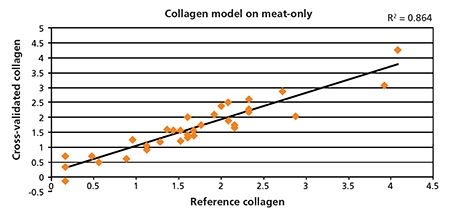The value of full-range spectrometers for the analysis of proteins.
The value of full-range spectrometers for the analysis of proteins:
Near-infrared (NIR) technology is reliable
- “Over the past 30 years, near infrared reflectance (NIR) spectroscopy has proved to be one of the most efficient and advanced tools for the estimation of quality attributes in meat and meat products.” [6]
- “Several applications of NIR demonstrated its ability to predict chemical composition of meat and to provide information on different molecular bonds and tissue ultrastructure.” [4]
NIR technology is portable
- ASD’s NIR systems can be used wherever the measurement is needed. Systems can be used in the laboratory, abbatoir, or on the production floor. NIR offers simple, rapid and cost effective real-time measurement
- “Near infrared spectroscopy (NIRS) has been developed and applied in quality management of beef meat products because it is a rapid, non-destructive and safe technique useful for simultaneous analysis.” [3]
- Spectra from ASD’s Vis-NIR spectrometer provides information that can be used to predict physical or sensory characteristics in meat samples. [6]
NIR is non-destructive
- In Salmonids, the use of NIR has enabled the direct measurement of live fish. Researchers have found that, during harvest operations, NIR provided a rapid and high-throughput tool that allowed them to measure compositional characteristics in a non-destructive manner. This allowed them to make key operational decisions related to harvest timing, processing methods, product classification and breeding selection. NIR technology has been successful for measurement of fat, moistures and other important characteristics.
Chemometrics (multivariate analysis) used to measure quantitative models:
- Collect and analyze NIR spectra and create models for quality, physicochemical and sensory characteristics of proteins: calories[5], collagen, cholesterol[5], moisture, protein, fat[5], fatty acids (FA)[6], whole muscle and meat beef pH, beef lightness, color determination[6] (water content of meat, concentration of myoglobin), thawing and cooking losses[4], sensory tenderness/toughness
Make multiple analyses with one measurement
- CAMO’s The Unscrambler® software and Thermo Fisher Scientific’s GRAMS IQ™ Spectroscopy Software Suite can be used to develop quantitative calibration models that are easily used with ASD’s LabSpec analyzer for real-time predictions
- Multivariate calibrations can be created to predict a variety of compositional or processing characteristics
- Regression analysis can be used to observe correlations of analytical data between variables.

Figure 1. The purpose of this test was to determine whether a calibration model for collagen in pork meat could be developed using an ASD spectrometer. A contact probe was placed directly on pork samples for spectra collection. Collagen modeled well with a correlation coefficient (RSQ) of 0.864. [1]
The solution
ASD spectrometers have high signal-to-noise design for optimal sensitivity and speed, combined with a spectral range of 350-2500nm, they are suitable for measurement of a variety of important processing parameters.
ASD offers different instrument configurations and many accessory options for a variety of set-up and sampling approaches for the most convenient and productive measurement scenarios:
LabSpec 4 offers laboratory-grade performance in a ruggedized, portable design suitable for benchtop analysis or transport to the sample location. Used for quantitative applications.
Contact Probe designed for contact measurements of solid raw materials.
Muglight designed for analysis of raw materials requiring reflectance and absorbance measurements.
Ideal for the analysis of proteins:
- Reliable
- Portable solution; suitable for lab and on-line
- Simple, rapid and cost effective real-time measurement
- Non-destructive
- Make multiple analyses with one measurement
References
1. ASD Inc. (2010). Evaluation of Pork Meat using LabSpec® 5000. Boulder, CO: Dan Shiley.
2. Brown, M. R., Kube, P. D., Taylor, R. S., & Elliott, N. G. (2014). Rapid compositional analysis of Atlantic salmon (Salmo salar) using visible-near infrared reflectance spectroscopy. Aquaculture Research, 45(5), 798-811.
3. De Marchi M., Berzaghi P., Boukha A., Merisola M., and Gallo L. (2007). Use of near infrared spectroscopy for assessment of meat quality traits. Ital. J. Anim. Sci. 6(Suppl. 1):421–423.
4. De Marchi, M., Penasa, M., Battagin, M., Zanetti, E., Pulici, C., and Cassandro, M. (2011). Feasibility of the direct application of near-infrared reflectance spectroscopy on intact chicken breasts to predict meat color and physical traits. Poultry Science. 90(7): 1594-1599. doi:10.3382/ps.2010-01239
5. Kandaswamy, J., Apple, J. K., & Bajwa, S. G. (2005). Ability of Near-Infrared Reflectance Spectroscopy to Predict Fat, Cholesterol, and Caloric Content of Fresh and Cooked Ground Beef. In: Arkansas Animal Science Department Report 2005.
6. Prieto, N., Ross, D. W., Navajas, E. A., Nute, G. R., Richardson, R. I., Hyslop, J. J., Simm, G., & Roehe, R. (2009). On-line application of visible and near infrared reflectance spectroscopy to predict chemical–physical and sensory characteristics of beef quality. Meat Science, 83(1), 96-103.
